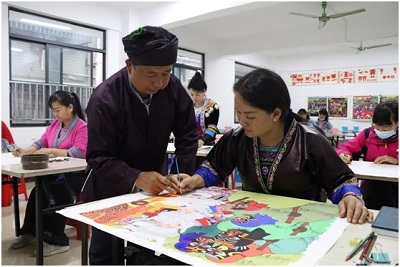By He Yong, People’s Daily
Some 70 kilometers upstream the Liuyang River from downtown Liuyang, central China’s Hunan province, there liesXiaohe, a township surrounded by mountains and home to over 400 farmer-turned-painters.
Zhan Qiuming is a quinquagenarianfarmer-turned-painter from Xiaohe’sXinhe village. Zhan has a genuine fondness for painting. “I want to paint it whenever I catch a glimpse of the mist surrounding the mountains in the field. When I see people playing along the glistening river in our village, I want to paint it, too,” the man told People’s Daily.
From a farmer that knew nothing about painting to an artist that is able to draw the beautiful sceneries in his hometown, it took Zhan more than three years to complete the transition.
Zhan used to live on a local mountain with his family. In 2016, they moved out of the mountain thanks to Xiaohe township’s efforts to advance new countryside construction. However, they only owned four mu (0.27 hectares) of farmland back then. To make a living, Zhan had to take part-time jobs nearby so that it was easier for him to take care of his old parents and school-aged son.
In 2017, Xiaohetownship decided to fight poverty by developing local industries and invited artists and art students to teach farmers to paint. It also signed contracts with relevant enterprises that would help the farmers sell their works.
Seeing his neighbors earning money from the painting business, Zhan encouraged his wife to join it. However, she was not cut out for painting, so Zhan tried it himself.
“I felt the paintbrush was heavier than a hoe when I picked it up for the first time,” Zhan said, explaining that he could barely control the paintbrush.
After a month, Zhan was able to draw only lines, but “quit” was not in his vocabulary. After every painting class, he kept learning online, and three months later, he sold his first work at five yuan ($0.73).
Now, a painting of his is worth around 600 to 700 yuan.
In a studio turned from a barn in the village, several farmers were busy painting, including Huang Baiyou.
“We have an ‘assembly line’ for producing the paintings, and I’m responsible for the first procedure,” said the 49-year-old woman, drawing lines in the studio.
Before joining the studio, Huang had worked in Dongguan, south China’s Guangdong province for 10 years, and she felt guilty of being far from home and not able to take care of her parents and children.
She quit the job in Dongguan and returned home soon after the studio was set up. “Now I can earn around 3,000 yuan per month. This job allows me to take care of both my crops and family,” she said.
The painting business is one of the industries vigorously developed by Xiaohetownship to align poverty reduction achievements with rural vitalization.
The township has five villages and 15,000 people. It was once the village that saw the highest poverty rate in Liuyang. Now, itis home to six painting studios and 460 farmer-turned-painters, whose works are sold to over 10 countries. The painting business has lifted 42 registered poor households in the township out of poverty.
In recent years, the township has built a series of internet-famous tourist attractions, attracting over 300,000 visitors on an annual basis. It has not only achieved targeted poverty alleviation, but also made the countryside beautiful and brought wealth to the farmers.
“I’ve never left my hometown my entire life, and I never thought that my paintings could go overseas,” Zhan told People’s Daily.













